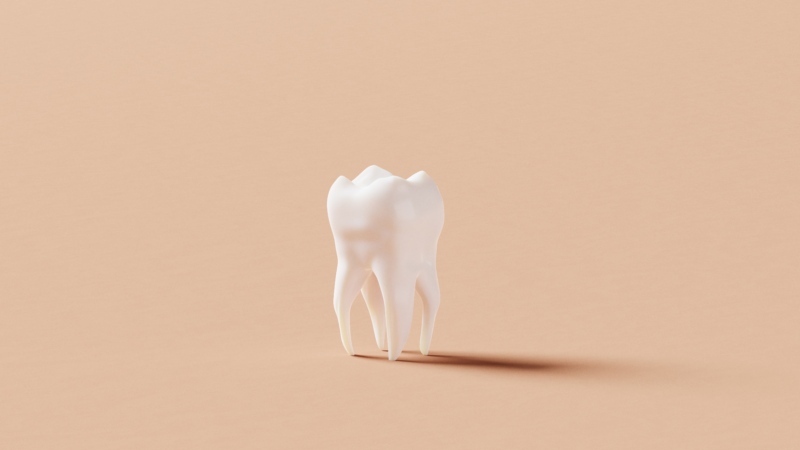Scientists grew human-like teeth in pigs. Could it lead to living tooth replacements?
Losing a tooth is tough.
If we lose the small living structures that help us chew our food, we’re left with the options of replacing them with dentures or implants that can be costly. Beyond that, there’s also the negative stigma around tooth loss people experience.
But researchers may be on track to developing a way to grow new, living teeth replacements. In a paper published in late December, a team at Tufts University reported having successfully grown human-like teeth in pigs.
Pamela Yelick, a professor at the Tufts School of Dental Medicine and lead researcher of the effort, said pigs have as many as five or six sets of teeth that grow throughout their lives.
If scientists can understand how pigs regrow and replace teeth so many times, Yelick said, they might be able to regrow teeth in people.
In their research, Yelick and her team took soft living tissue from both human and pig teeth, combined them in a lab, and then transplanted it into a mini pig’s mouth. They obtained the materials from pig jawbones and human teeth extracted for orthodontic reasons.
“In a few months, you can get a pretty good sized bioengineered tooth,” Yelick said, noting that while it’s “not perfect” in shape or size, the end product does closely resemble a natural tooth.
The science is not ready to be used in humans just yet, Yelick said. But she is hopeful that with advancements the fields of regenerative medicine and dentistry will accelerate the ability to create new teeth and other organs.
Yelick says the idea is to study how pig teeth grow and then try to figure out how to replicate that process in people. She says this research could help improve how we repair and replace our teeth so that they are stronger and last longer.
“When you think of a tooth crown or a dental implant, some of the methods that have been used have been around for a hundred years,” Yelick said. “Time to get some better substitutes out there.”
You can read about the team’s findings here.
Transcript:
MICHEL MARTIN, HOST:
Hey, A.
A MARTÍNEZ, HOST:
Yeah.
MARTIN: I have some dental news.
MARTÍNEZ: OK.
MARTIN: Scientists have figured out how to grow human-like teeth…
MARTÍNEZ: Oh. That’s cool.
MARTIN: …In pigs.
MARTÍNEZ: Oh.
MARTIN: (Laughter)
MARTÍNEZ: Say that again.
MARTIN: Yes. Scientists have figured out how to grow human teeth in living pigs.
MARTÍNEZ: OK, please tell me boar.
MARTIN: (Laughter) OK, well, I don’t know about that, but I’m going to let Pamela Yelick tell you. She’s a professor at the School of Dental Medicine at Tufts University.
PAMELA YELICK: Pig jaws, they’re very similar to human jaws. So the pig is a nice model to use for looking at tooth development.
MARTÍNEZ: How are they similar?
MARTIN: Yelick says pigs have multiple sets of teeth, just like humans. But unlike humans, pigs regrow them throughout their lifetime.
YELICK: So, you know, we have baby teeth and then adult teeth. So humans have two sets of teeth. Pigs have five and six, depending on the strain of pig.
MARTIN: She says if scientists can understand how pigs regrow and replace teeth so many times, they might be able to regrow teeth in people.
MARTÍNEZ: Oh, all right. So what did her team do?
MARTIN: Well, first, you have to understand that your teeth are living.
YELICK: And the reason is because the middle of the tooth contains soft tissue that has cells in it, and it also has blood vessels and nerves, and it’s living. It’s vital.
MARTIN: Yelick and her team took that soft living tissue from both human and pig teeth, combined them in a lab, and then transplanted it into pig’s mouths.
YELICK: In a few months, you can get a pretty good sized bio-engineered tooth. Now, it’s not perfect. It’s not perfectly shaped or sized, but closely resembles a natural tooth.
MARTÍNEZ: So in their experiment, they were able to take that tooth, grown into the pig, and then put it in a person?
MARTIN: No, not at this stage.
MARTÍNEZ: Oh.
MARTIN: No. So the idea, Yelick says, is to study how teeth grow and then try to figure out how to replicate that process in people. She says this research could help improve how we repair and replace our teeth so that they are stronger and last longer.
YELICK: When you think about tooth crown or a dental implant, some of the methods that have been used have been around for 100 years. Time to get some better tooth substitutes out there.
MARTÍNEZ: And I got to imagine, it’s going to take a few more years, at least, before this technology finds its way in our mouths.
MARTIN: Right. Although, Yelick says, it’s still an exciting time.
YELICK: There are a lot of advances that have been made which are accelerating this whole process. So it will happen. It will happen. I hope in my lifetime.
MARTIN: Which, you know, should put a smile on our faces.
(SOUNDBITE OF MUSIC)
MARTIN: Some people’s. Maybe mine.
MARTÍNEZ: (Laughter).
Tributes, not politics, play center stage as Trump hosts the Kennedy Center Honors
President Trump said he was closely involved with picking the honorees, and on Sunday he became the first president to host the Kennedy Center awards ceremony.
Thailand launches airstrikes along border with Cambodia as tensions reignite
Both sides accused the other of breaking a ceasefire that halted fighting earlier this year. Longstanding border disputes erupted into five days of combat in July that killed dozens.
Rafael Ithier, a legend of salsa music, dies at 99
The pianist, composer and arranger spent more than six decades turning El Gran Combo into one of the premier salsa institutions of Latin America and beyond.
Light from satellites will ruin majority of some space telescope images, study says
Astronomers have long been concerned about reflections from satellites showing up in images taken by telescopes and other scientific instruments.
Defense Department is reviewing boat strike video for possible release, Hegseth says
In a speech on Saturday, Defense Secretary Pete Hegseth defended the strikes, saying: "President Trump can and will take decisive military action as he sees fit to defend our nation's interests."
Bama, Miami in, Notre Dame out and Indiana No. 1 in College Football Playoff rankings
Nobody paying attention for the past 24 months would be surprised to see Indiana – yes, Indiana – leading the way into this year's College Football Playoff.









